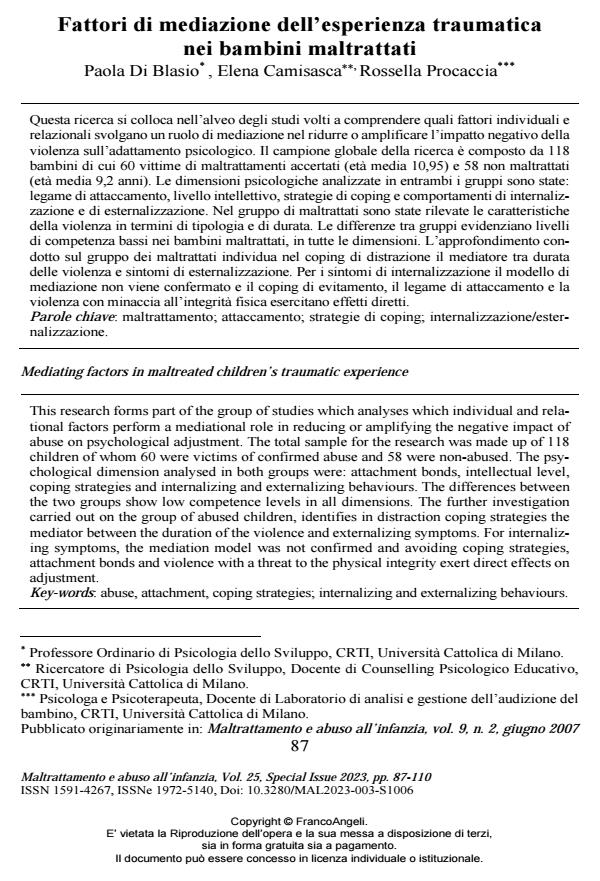Fattori di mediazione dell’esperienza traumatica nei bambini maltrattati
Titolo Rivista MALTRATTAMENTO E ABUSO ALL’INFANZIA
Autori/Curatori Paola Di Blasio, Elena Camisasca, Rossella Procaccia
Anno di pubblicazione 2024 Fascicolo 2023/3 Suppl.
Lingua Italiano Numero pagine 24 P. 87-110 Dimensione file 244 KB
DOI 10.3280/MAL2023-003-S1006
Il DOI è il codice a barre della proprietà intellettuale: per saperne di più
clicca qui
Qui sotto puoi vedere in anteprima la prima pagina di questo articolo.
Se questo articolo ti interessa, lo puoi acquistare (e scaricare in formato pdf) seguendo le facili indicazioni per acquistare il download credit. Acquista Download Credits per scaricare questo Articolo in formato PDF

FrancoAngeli è membro della Publishers International Linking Association, Inc (PILA)associazione indipendente e non profit per facilitare (attraverso i servizi tecnologici implementati da CrossRef.org) l’accesso degli studiosi ai contenuti digitali nelle pubblicazioni professionali e scientifiche
Questa ricerca si colloca nell’alveo degli studi volti a comprendere quali fattori individuali e relazionali svolgano un ruolo di mediazione nel ridurre o amplificare l’impatto negativo della violenza sull’adattamento psicologico. Il campione globale della ricerca è composto da 118 bambini di cui 60 vittime di maltrattamenti accertati (età media 10,95) e 58 non maltrattati (età media 9,2 anni). Le dimensioni psicologiche analizzate in entrambi i gruppi sono state: legame di attaccamento, livello intellettivo, strategie di coping e comportamenti di internalizzazione e di esternalizzazione. Nel gruppo di maltrattati sono state rilevate le caratteristiche della violenza in termini di tipologia e di durata. Le differenze tra gruppi evidenziano livelli di competenza bassi nei bambini maltrattati, in tutte le dimensioni. L’approfondimento condotto sul gruppo dei maltrattati individua nel coping di distrazione il mediatore tra durata delle violenza e sintomi di esternalizzazione. Per i sintomi di internalizzazione il modello di mediazione non viene confermato e il coping di evitamento, il legame di attaccamento e la violenza con minaccia all’integrità fisica esercitano effetti diretti.
Parole chiave:maltrattamento; attaccamento; strategie di coping; internalizzazione/esternalizzazione.
Paola Di Blasio, Elena Camisasca, Rossella Procaccia, Fattori di mediazione dell’esperienza traumatica nei bambini maltrattati in "MALTRATTAMENTO E ABUSO ALL’INFANZIA" 3 Suppl./2023, pp 87-110, DOI: 10.3280/MAL2023-003-S1006